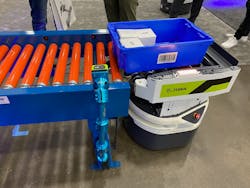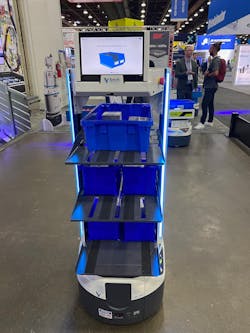Just as the supply chain issues created by COVID-19 put a spotlight on the need to better integrate supply chain systems data with manufacturing operations software, we’re seeing another example of technology often used in warehouse applications proving to be beneficial in manufacturing. In this case, it’s the use of autonomous mobile robots (AMRs) for materials conveyance.
In manufacturing operations, these AMRs have long been used to transport parts and materials from one area to another. But in these applications, the intelligence of the AMR systems largely revolved around collision avoidance to safely navigate from one place to the next. For AMRs to provide additional value, they need to be integrated with workflow software and other material handling systems in the factory or warehouse. This kind of integration is behind Zebra Technologies’ expansion into AMR use.
According to Zebra, AMRs are a key aspect in a manufacturer’s automation strategy as they can be used to “automate the transport of work-in-progress materials between production lines or work cells, including sub-assemblies produced in various production stages. As products progress in the assembly process, they can be transported to testing and quality control areas, with any defects being sent to repair or back to the line by AMRs as well. Finished goods can be transported to pack out and then on to storage or directly to shipping. AMRs can also support the on-demand replenishment of floor stock materials and transport waste materials out of production areas to ensure staging areas are free and clear of trash and recyclables.”
Zebra’s hardware and software integration
Long known for its bar code scanners, RFID technology and printers, Zebra expanded further into warehouse and manufacturing automation with its acquisition of Fetch Robotics in 2021. During a meeting at Automate 2023, Jim Lawton, vice president and general manager of robotics automation at Zebra, pointed out that Zebra acquired Fetch Robotics largely in response to customer requests for more integrated automation capabilities from Zebra that would allow them to more easily deploy and support automated materials transport in their facilities and deliver a quick return on investment.
The Velocity workflow software offered by Zebra through its partnership with Ivanti ingests orders from enterprise software, such as ERP or warehouse management systems, to make decisions about priorities based on optimizations directed by the software, explained Lawton. “This software has a workflow builder that uses drag-and-drop to program the robots,” he added. “And it integrates with Zebra wearables to make pickers more effective within hours rather than weeks of training on the job.”
Though this combination of software and hardware has clear warehouse applications, Lawton said that more than half of Zebra’s deployments of these technologies are in manufacturing. He pointed out that Zebra’s manufacturing industry customers typically use these systems for line-side replenishment and just-in-time manufacturing applications, but also for e-commerce fulfillment operations.
Increased manufacturing interest in AMRs
“Bottlenecks at staging or storage areas can create a nightmare scenario for operations, where you have the goods in house but aren’t delivering on-time because of internal logjams,” said Alex Evans, vice president of product management at Ivanti. “In the past, companies may have employed a ‘runner’ or assigned a team member to simply help them dig out of this backlog. Now, rather than re-assigning workers from other tasks, automation—particularly AMRs—provide a big collaborative value to help eliminate this problem.”
Explaining why AMRs are proving to be of more value to manufacturers than traditional conveyance systems, Harty said, “A conveyor is often unidirectional, so your material must always travel in one direction. If a stop is missed or item not diverted at the right junction, it’s possible that item needs to go through the entire loop again, which could be hundreds or even thousands of feet. We’ve heard customers mention that products can be trapped in a conveyor loop for days without being noticed. Because AMRs are omni-directional and can autonomously travel from point to point without a fixed path, they can bypass all the extra stops along a traditional conveyor route and move directly to their next destination. This allows product to move more flexibly and efficiently throughout the facility and eliminates standard bottlenecks in fixed automation.”
Evans noted that AMRs should be viewed as a way to augment a human worker’s ability to accomplish more each shift. “Workers can be empowered to delegate material movement from their wearable device to an AMR with a command such as: ‘this tote is ready to be brought to the staging area,’” he said. “Because the AMR is already plugged into the workflow, it can recognize where the assigned tote is, where it needs to go, and can confirm back to the human worker and the host application once that tote has been delivered to staging. Meanwhile, the human worker has already been actively working on another task, so multiple workflows advance simultaneously.”



